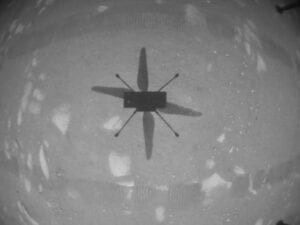
Paris, 20 April 2021. – 39.1 historic seconds: NASA’s Mars Helicopter Ingenuity succeeded to become the first aircraft in history to make a powered, controlled flight on another planet.
The Ingenuity team at the agency’s Jet Propulsion Laboratory (JPL) in Southern California confirmed the flight succeeded after receiving data from the helicopter via NASA’s Perseverance Mars rover last night.
Ingenuity climbed to its prescribed maximum altitude of 3 meters and maintained a stable hover for 30 seconds, NASA said. It then descended, touching back down on the surface of Mars after 39.1 seconds of flight.
Parked 65 meters away during Ingenuity’s historic flight, the Perseverance rover acted as a communications relay between the helicopter and Earth and chronicled the flight operations with its cameras.
Ingenuity’s initial flight demonstration was autonomous – piloted by onboard guidance, navigation, and control systems running algorithms developed by the team at JPL, NASA said. Because data must be sent to and returned from the Red Planet over hundreds of millions of miles using orbiting satellites and NASA’s Deep Space Network, Ingenuity cannot be flown with a joystick, the U.S. agency said, and its flight was not observable from Earth in real-time.
“Now, 117 years after the Wright brothers succeeded in making the first flight on our planet, NASA’s Ingenuity helicopter has succeeded in performing this amazing feat on another world,” NASA Associate Administrator for Science Thomas Zurbuchen said. “While these two iconic moments in aviation history may be separated by time and 173 million miles of space, they now will forever be linked. As a homage to the two innovative bicycle makers from Dayton, this first of many airfields on other worlds will now be known as Wright Brothers Field, in recognition of the ingenuity and innovation that continue to propel exploration.”
 SpaceWatch.Global An independent perspective on space
SpaceWatch.Global An independent perspective on space




